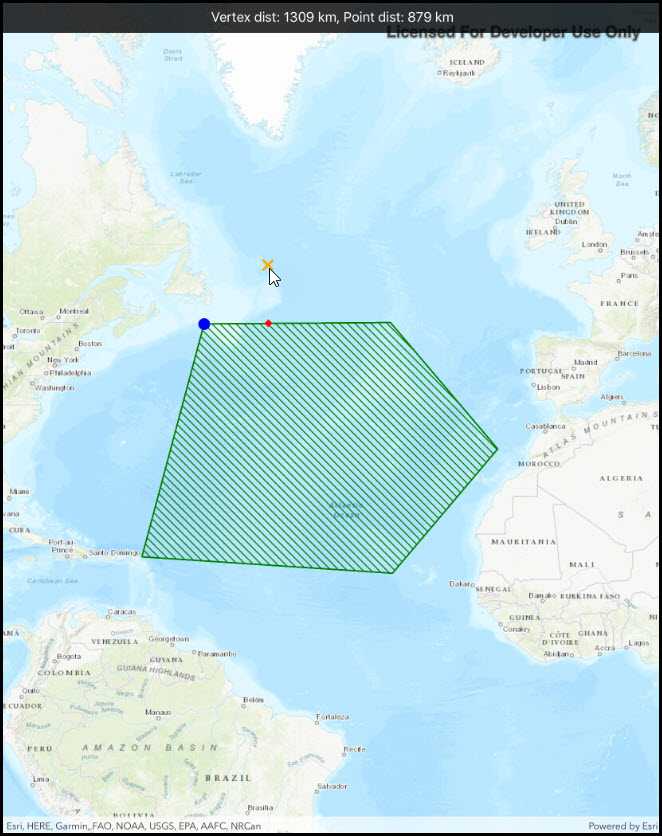Find the closest vertex and coordinate of a geometry to a point.

Use case
Determine the shortest distance between a location and the boundary of an area. For example, developers can snap imprecise user clicks to a geometry if the tap is within a certain distance of the geometry.
How to use the sample
Tap anywhere on the map. An orange cross will show at that location. A blue circle will show the polygon's nearest vertex to the point that was clicked. A red diamond will appear at the coordinate on the geometry that is nearest to the point that was clicked. If clicked inside the geometry, the red and orange markers will overlap. The information box showing distance between the clicked point and the nearest vertex/coordinate will be updated with every new location clicked.
How it works
- Get a
Geometryand aPointto check the nearest vertex against. - Call
GeometryEngine.NearestVertex(inputGeometry, point). - Use the returned
ProximityResultto get thePointrepresenting the polygon vertex, and to determine the distance between that vertex and the clicked point. - Call
GeometryEngine.NearestCoordinate(inputGeometry, point). - Use the returned
ProximityResultto get thePointrepresenting the coordinate on the polygon, and to determine the distance between that coordinate and the clicked point.
Relevant API
- GeometryEngine
- ProximityResult
Tags
analysis, coordinate, geometry, nearest, proximity, vertex
Sample Code
// Copyright 2020 Esri.
//
// Licensed under the Apache License, Version 2.0 (the "License"); you may not use this file except in compliance with the License.
// You may obtain a copy of the License at: http://www.apache.org/licenses/LICENSE-2.0
//
// Unless required by applicable law or agreed to in writing, software distributed under the License is distributed on an
// "AS IS" BASIS, WITHOUT WARRANTIES OR CONDITIONS OF ANY KIND, either express or implied. See the License for the specific
// language governing permissions and limitations under the License.
using Esri.ArcGISRuntime.Geometry;
using Esri.ArcGISRuntime.Mapping;
using Esri.ArcGISRuntime.Symbology;
using Esri.ArcGISRuntime.UI;
using Esri.ArcGISRuntime.UI.Controls;
using Foundation;
using System.Drawing;
using UIKit;
namespace ArcGISRuntime.Samples.NearestVertex
{
[Register("NearestVertex")]
[ArcGISRuntime.Samples.Shared.Attributes.Sample(
name: "Nearest vertex",
category: "Geometry",
description: "Find the closest vertex and coordinate of a geometry to a point.",
instructions: "Tap anywhere on the map. An orange cross will show at that location. A blue circle will show the polygon's nearest vertex to the point that was clicked. A red diamond will appear at the coordinate on the geometry that is nearest to the point that was clicked. If clicked inside the geometry, the red and orange markers will overlap. The information box showing distance between the clicked point and the nearest vertex/coordinate will be updated with every new location clicked.",
tags: new[] { "analysis", "coordinate", "geometry", "nearest", "proximity", "vertex" })]
public class NearestVertex : UIViewController
{
// Hold references to UI controls.
private MapView _myMapView;
private UILabel _distanceLabel;
// Hold references to the graphics overlay and the polygon graphic.
private GraphicsOverlay _graphicsOverlay;
private Graphic _polygonGraphic;
// Hold references to the graphics for the user and results points.
private Graphic _tappedLocationGraphic;
private Graphic _nearestVertexGraphic;
private Graphic _nearestCoordinateGraphic;
public NearestVertex()
{
Title = "Nearest vertex";
}
private void Initialize()
{
// Configure the basemap.
_myMapView.Map = new Map(BasemapStyle.ArcGISTopographic);
// Create the graphics overlay and set the selection color.
_graphicsOverlay = new GraphicsOverlay();
// Add the overlay to the MapView.
_myMapView.GraphicsOverlays.Add(_graphicsOverlay);
// Create the point collection that defines the polygon.
PointCollection polygonPoints = new PointCollection(SpatialReferences.WebMercator)
{
new MapPoint(-5991501.677830, 5599295.131468),
new MapPoint(-6928550.398185, 2087936.739807),
new MapPoint(-3149463.800709, 1840803.011362),
new MapPoint(-1563689.043184, 3714900.452072),
new MapPoint(-3180355.516764, 5619889.608838)
};
// Create the polygon.
Polygon polygonGeometry = new Polygon(polygonPoints);
// Define and apply the symbology.
SimpleLineSymbol polygonOutlineSymbol = new SimpleLineSymbol(SimpleLineSymbolStyle.Solid, Color.Green, 2);
SimpleFillSymbol polygonFillSymbol = new SimpleFillSymbol(SimpleFillSymbolStyle.ForwardDiagonal, Color.Green, polygonOutlineSymbol);
// Create the graphic and add it to the graphics overlay.
_polygonGraphic = new Graphic(polygonGeometry, polygonFillSymbol);
_graphicsOverlay.Graphics.Add(_polygonGraphic);
// Create the graphics and symbology for the tapped point, the nearest vertex, and the nearest coordinate.
SimpleMarkerSymbol tappedLocationSymbol = new SimpleMarkerSymbol(SimpleMarkerSymbolStyle.X, Color.Orange, 15);
SimpleMarkerSymbol nearestCoordinateSymbol = new SimpleMarkerSymbol(SimpleMarkerSymbolStyle.Diamond, Color.Red, 10);
SimpleMarkerSymbol nearestVertexSymbol = new SimpleMarkerSymbol(SimpleMarkerSymbolStyle.Circle, Color.Blue, 15);
_nearestCoordinateGraphic = new Graphic { Symbol = nearestCoordinateSymbol };
_tappedLocationGraphic = new Graphic { Symbol = tappedLocationSymbol };
_nearestVertexGraphic = new Graphic { Symbol = nearestVertexSymbol };
_graphicsOverlay.Graphics.Add(_tappedLocationGraphic);
_graphicsOverlay.Graphics.Add(_nearestVertexGraphic);
_graphicsOverlay.Graphics.Add(_nearestCoordinateGraphic);
// Center the map on the polygon.
_myMapView.SetViewpointCenterAsync(polygonGeometry.Extent.GetCenter(), 200000000);
}
private void MyMapView_GeoViewTapped(object sender, GeoViewInputEventArgs geoViewInputEventArgs)
{
// Get the tapped location.
MapPoint tappedLocation = (MapPoint)GeometryEngine.NormalizeCentralMeridian(geoViewInputEventArgs.Location);
// Show the tapped location.
_tappedLocationGraphic.Geometry = tappedLocation;
// Get the nearest vertex in the polygon.
ProximityResult nearestVertexResult = GeometryEngine.NearestVertex(_polygonGraphic.Geometry, tappedLocation);
// Get the nearest coordinate in the polygon.
ProximityResult nearestCoordinateResult =
GeometryEngine.NearestCoordinate(_polygonGraphic.Geometry, tappedLocation);
// Get the distance to the nearest vertex in the polygon.
int distanceVertex = (int)(nearestVertexResult.Distance / 1000);
// Get the distance to the nearest coordinate in the polygon.
int distanceCoordinate = (int)(nearestCoordinateResult.Distance / 1000);
// Show the nearest vertex in blue.
_nearestVertexGraphic.Geometry = nearestVertexResult.Coordinate;
// Show the nearest coordinate in red.
_nearestCoordinateGraphic.Geometry = nearestCoordinateResult.Coordinate;
// Show the distances in the UI.
_distanceLabel.Text = $"Vertex dist: {distanceVertex} km, Point dist: {distanceCoordinate} km";
}
public override void ViewDidLoad()
{
base.ViewDidLoad();
Initialize();
}
public override void LoadView()
{
// Create the views.
View = new UIView() { BackgroundColor = ApplicationTheme.BackgroundColor };
_myMapView = new MapView();
_myMapView.TranslatesAutoresizingMaskIntoConstraints = false;
_distanceLabel = new UILabel
{
Text = "Tap to see the nearest vertex and point.",
TextAlignment = UITextAlignment.Center,
BackgroundColor = UIColor.FromWhiteAlpha(0, .8f),
TextColor = UIColor.White,
TranslatesAutoresizingMaskIntoConstraints = false
};
// Add the views.
View.AddSubviews(_myMapView, _distanceLabel);
// Lay out the views.
NSLayoutConstraint.ActivateConstraints(new[]
{
_myMapView.TopAnchor.ConstraintEqualTo(View.SafeAreaLayoutGuide.TopAnchor),
_myMapView.LeadingAnchor.ConstraintEqualTo(View.LeadingAnchor),
_myMapView.TrailingAnchor.ConstraintEqualTo(View.TrailingAnchor),
_myMapView.BottomAnchor.ConstraintEqualTo(View.BottomAnchor),
_distanceLabel.TopAnchor.ConstraintEqualTo(View.SafeAreaLayoutGuide.TopAnchor),
_distanceLabel.LeadingAnchor.ConstraintEqualTo(View.LeadingAnchor),
_distanceLabel.TrailingAnchor.ConstraintEqualTo(View.TrailingAnchor),
_distanceLabel.HeightAnchor.ConstraintEqualTo(40)
});
}
public override void ViewWillAppear(bool animated)
{
base.ViewWillAppear(animated);
// Subscribe to events.
_myMapView.GeoViewTapped += MyMapView_GeoViewTapped;
}
public override void ViewDidDisappear(bool animated)
{
base.ViewDidDisappear(animated);
// Unsubscribe from events, per best practice.
_myMapView.GeoViewTapped -= MyMapView_GeoViewTapped;
}
}
}